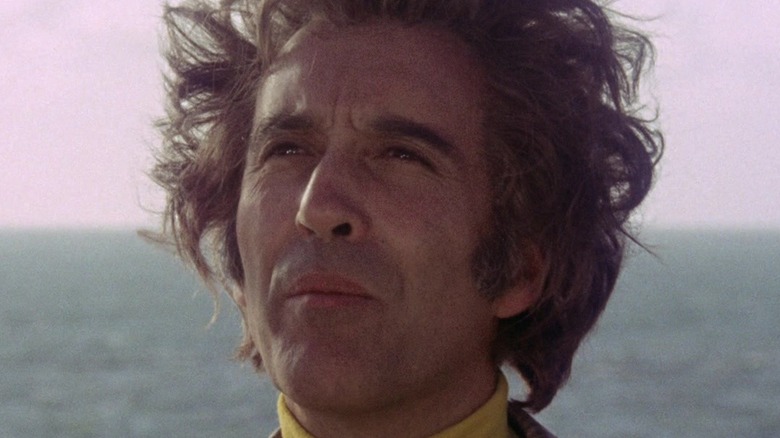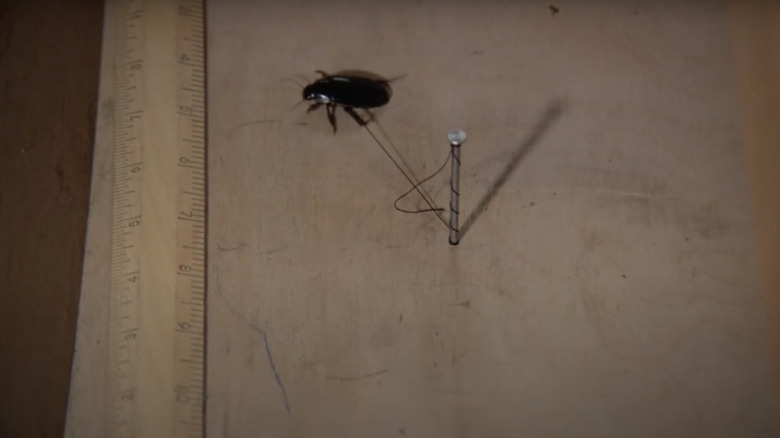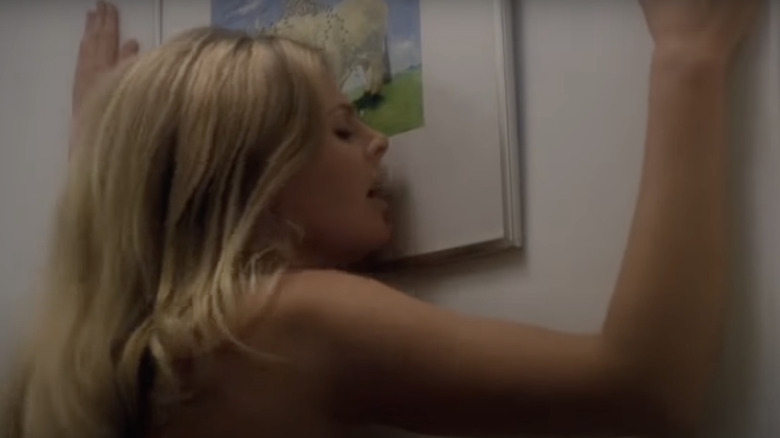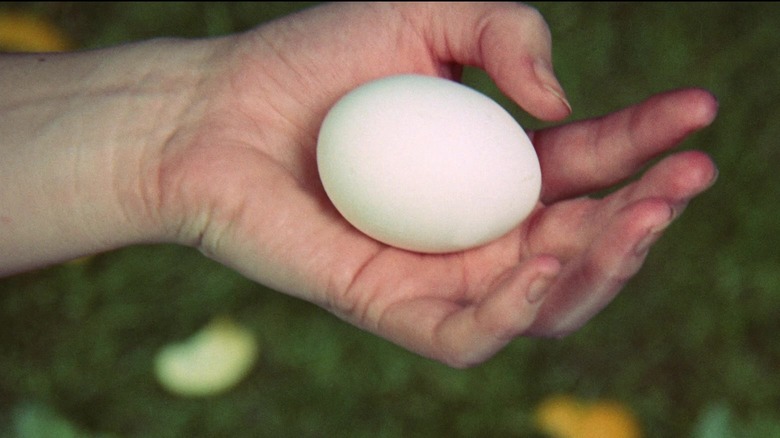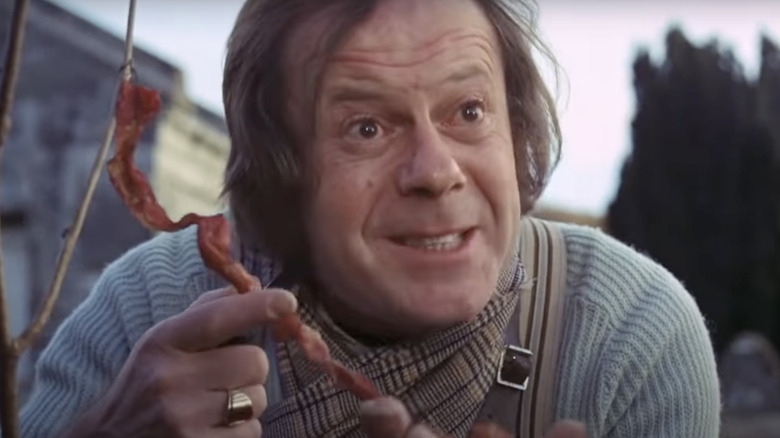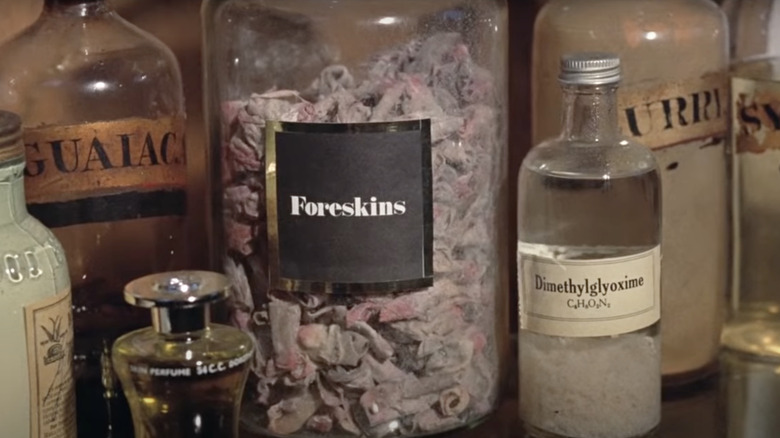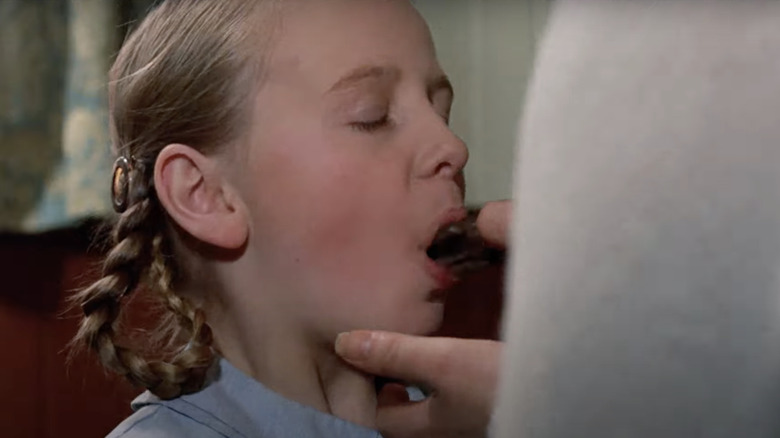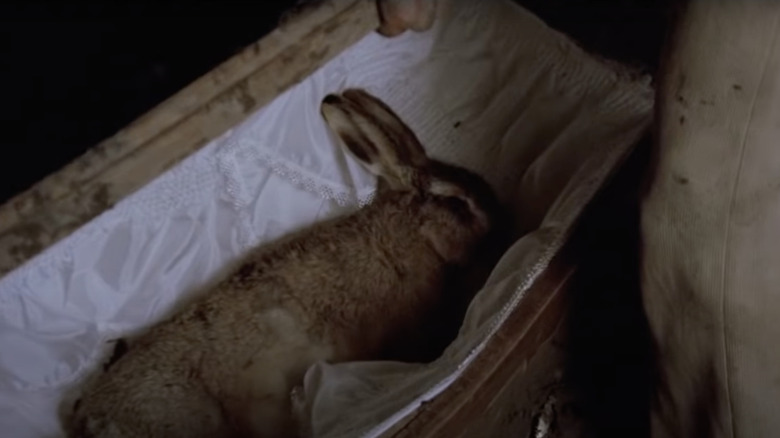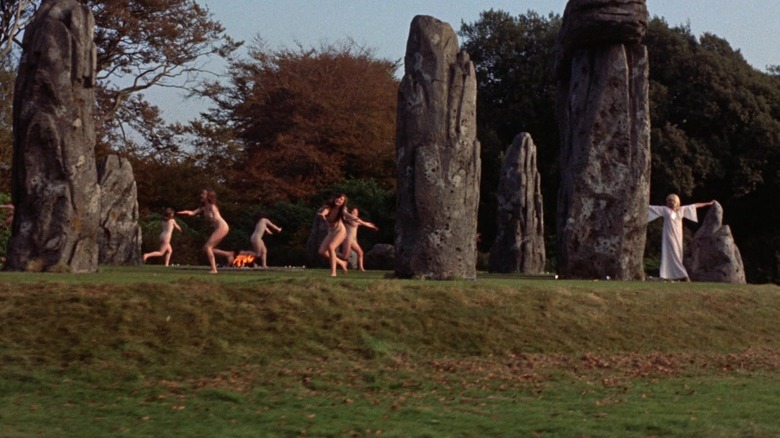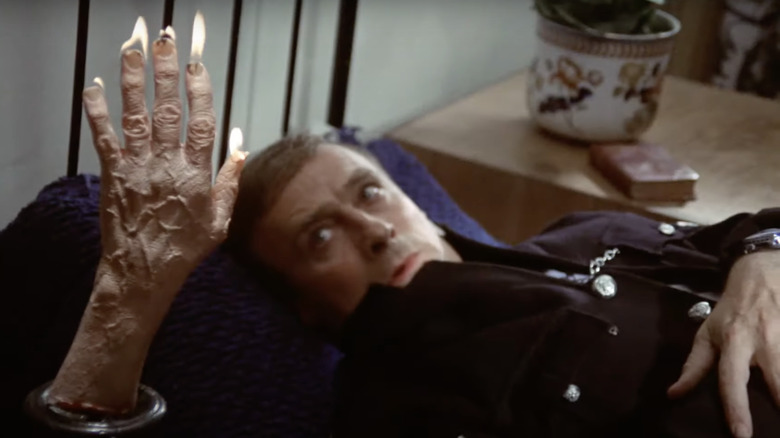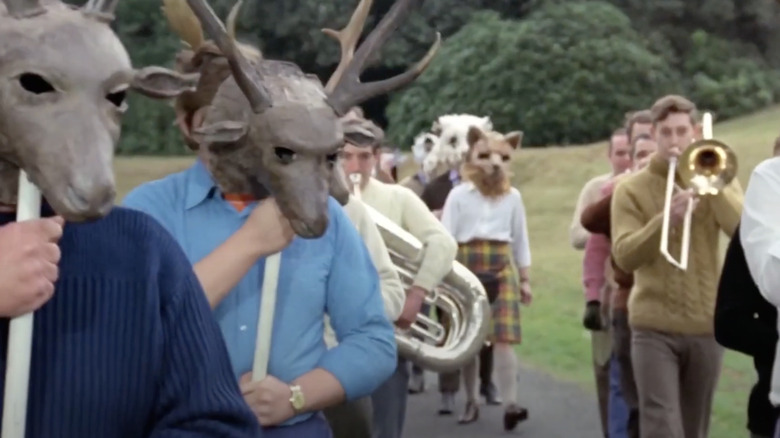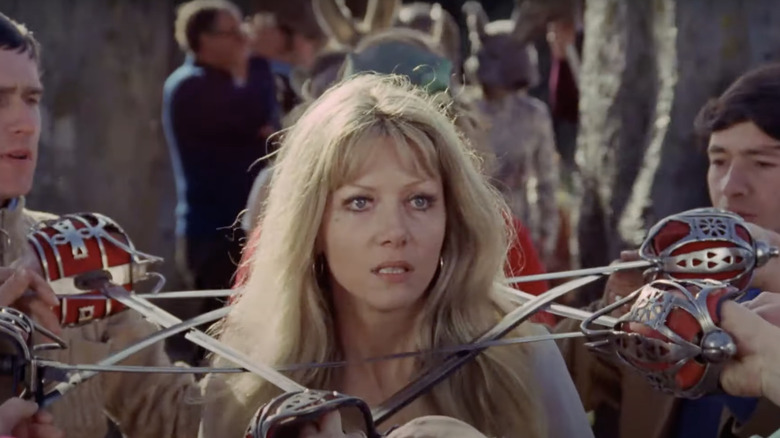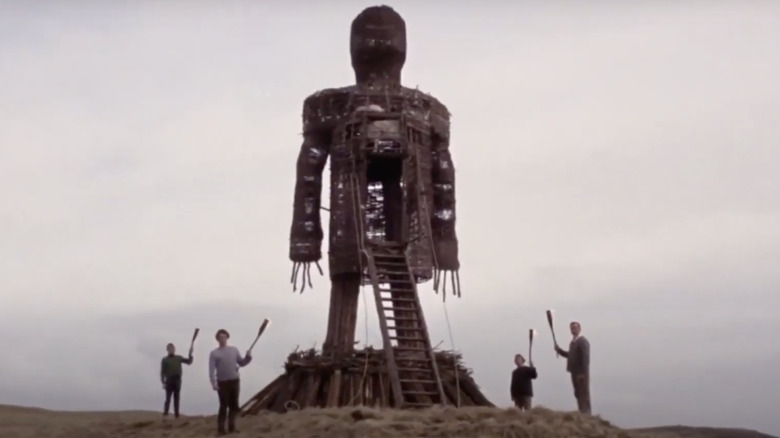The 12 Strangest Moments In 1973's The Wicker Man
The best known of the original "unholy trinity" of folk horror films (which also includes 1968's "Witchfinder General" and 1971's "The Blood on Satan's Claw"), 1973's "The Wicker Man" written by Anthony Shaffer and directed by Robin Hardy has stood the test of time. In fact, it recently clocked in at number 19 on Rolling Stone's list of the 101 best horror movies. And while the film's simple premise — policeman visits island in search of missing child, happens upon old-time religious sect, is received coldly by community — doesn't immediately read as "scary," the film's many oddities have enough basis in truth to render the narrative strangely, menacingly plausible.
in his video "A Beginner's Guide," "Evolution of Horror" podcast host Mike Muncer quotes film scholar Adam Scovell's definition of folk horror as follows: each film is set in a rural location, features an isolated group that possesses skewed morals and beliefs, and (usually) ends with a violent supernatural happening. "The Wicker Man," which adheres to at least three of these, influenced a generation of filmmakers, each of whom has contributed entries to the subgenre: Ari Aster's "Midsommar," Robert Eggers' "The VVitch," and Ben Wheatley's "A Field in England" and "In the Earth." But whereas these directors have invented their own mythologies, "The Wicker Man" leans on existing Celtic and pagan beliefs that date back hundreds of years. Let's take a look at the film's strangest moments and the meanings behind them. (Warning: major spoilers ahead. Also, like "The Wicker Man" itself, parts of this article get kind of gross.)
Beetle on a string
In "The Wicker Man," Sgt. Neil Howie (Edward Woodward), a Scottish policeman from the mainland, arrives at Summerisle in search of Rowan Morrison (Geraldine Cowper), a girl he has been informed is missing. One of Howie's first stops is a schoolyard where boys are dancing robotically around a maypole singing a song about fertility, and the girls (who appear to be around 11 or 12) are learning a lesson about phallic symbols. Needless to say, Howie is shocked by the lesson, but to the matter at hand — where is Rowan, and why is her desk unoccupied? None of the students or their teacher, Miss Rose (Diane Cilento), seem to know. When Howie opens the desk, he is greeted by the sight of a beetle tied to a string which is tied to a nail in the center of the desk. "The beetle goes round and round, you see," a girl tells Howie, "until he ends up tight to the nail. Poor old thing." The scene takes on increasing significance the more Howie learns about Summerisle, as the net closes tighter around him until he is finally, tragically, out of options.
Willow's dance
There's been a good deal of speculation as to why Howie is chosen by Lord Summerisle (Christopher Lee) as the island's sacrifice and how he, of all God-fearing men from the mainland, is found. And while some scenes that would have further explained Howie's behavior ended up on the cutting room floor, once Howie arrives on the island, many assume he's done for. Or is he? In one infamous scene that takes place above the local pub, Howie's loyalty to his faith — and his virginity — is put to the test as the landlord's comely daughter Willow (Britt Ekland) performs a suggestive dance in the nude in the room next to Howie's, thumping repeatedly on their adjoining walls. The dance, performed as Willow sings Paul Giovanni's aptly titled ballad "Willow's Song," features only certain aspects of Ekland as, according to Ekland, apparently a decision was made without her knowledge to use a body double for certain shots. The scene is often cited by fans as the "test" Howie passes in order to become, in the eyes of Summerisle, the ideal sacrifice.
Churchyard tableau
Certain scenes in "The Wicker Man" are, intentionally or otherwise, laugh-out-loud funny. Others are downright bizarre. Some fall into another category — uncanny. As Howie makes his way around Summerisle, he stumbles into the remains of a churchyard in which symbols of Christianity have been removed or destroyed, causing him to fashion a makeshift cross. With the community worshiping primarily gods of nature in a religion based on pagan beliefs that emphasizes the need for birth, regeneration, and an ample harvest, it's hardly shocking that Howie would come across the strange tableau of a breastfeeding woman (Barbara Ann Brown) holding an egg in her left hand. The symbolism isn't hard to fathom. According to Art Dependence magazine, "The egg has always held particular symbolic significance, partly because it is a visual shorthand for new life and un-hatched potential. The egg brings hope and purity. It is a symbol of fertility and the circle of life."
The navel string
Among the less appetizing objects to appear in "The Wicker Man" is what we're told is the dried umbilical cord, or "navel string," of Rowan Morrison. Howie finds it tied to a young tree growing atop Morrison's "grave," attended by the Gardener (Aubrey Morris), who informs Howie that the girl has been dead "six or seven months." The string is another in a line of clues that lead Sgt. Howie to the conclusion that this anti-Christian society may be complicit in the death of the girl. He'll change his tune later on, of course; but if he had done his homework, he would know that keeping the umbilicus is a time-honored tradition that is still practiced today, and not just on the pagan fringe. According to BBC News, there are multiple uses for the cord, including donating it for blood (the stem cells contained within it can be life-changing for some), making it into a necklace, storing it in a keepsake box, burning it (don't ask), or just getting rid of it. There are also sites around the world where, like in "The Wicker Man," an umbilical cord may be planted along with a new tree.
The jar of foreskins
It should come as no surprise that a community that hangs on to umbilical cords would keep foreskins as well. And while we can puzzle as to why this particular society is practicing circumcision, we can assume the procedure is alive and well on Summerisle based on the presence of a conveniently marked jar at the chemist's shop. As it happens, foreskin has a history as rich as the cells within it that produce collagen, a binding agent often used in beauty products. According to Ranker, foreskin cells can be used for stimulating hair growth, creating stem cells (not unlike umbilical cord blood), making facial cream, restoring damaged or aged skin, treating bed sores and ulcers, and for bioengineering skin for burn victims. One thing the residents of Summerisle cannot be accused of — wasting body parts.
For some reason, the jar sits next to a bottle of dimethylglyoxime, which is, per Geeks for Geeks, a substance used in analytical chemistry "as a detecting reagent, precipitating reagent, and photometric reagent for metal ions such as platinum, palladium, and nickel" — specifically, on jewelry and other objects that come in contact with the skin. Deeper meaning? We'll get back to you on that.
The old frog in the mouth trick
One of the most memorably bizarre sequences in "The Wicker Man" involves the mother of the "fallen" Rowan Morrison May Morrison (Irene Sunters), a little girl, and a frog. The scene, which depends on some camera trickery, features a girl complaining of a sore throat who is treated with a folk remedy involving the placement of a small frog in her mouth. She is told to keep her mouth shut for a few moments, and then the frog is extracted. The girl is clearly unhappy with the remedy, but is given her choice of sweets afterward, and goes on her merry way. The custom, as it turns out, was apparently the Chloraseptic of the medieval era — it was thought the answer to a cough and sore throat was to hold a frog in the mouth for a few seconds, and after, the frog would make off with the illness. Needless to say, Howie isn't having any of it. After he witnesses the treatment, May turns and asks if she can help him with anything; Howie responds, "I doubt it, seeing as you're all raving mad."
The old hare in the coffin trick
While the main mystery of "The Wicker Man" has to do with the whereabouts of Rowan Morrison, Howie eventually concludes that she is dead, and asks Lord Summerisle for permission to exhume the body, which is granted. When Howie and the Gardener do so, they open the coffin and find a freshly deceased hare in place of the girl. It's not surprising if you've been paying attention. March hares appear in various forms throughout "The Wicker Man," including chocolate versions in May Morrison's sweet shop. According to Marianne Taylor in Country Life, "In the Middle Ages, hares were linked, like certain other enigmatic creatures, to witchcraft... it was common knowledge that, with the right incantation, a witch could assume a hare's shape, complete with its speed, power and ability to vanish at will." Tok Thompson of the University of Southern California writes that hares in Europe are interchangeable with the American Easter Bunny, with the holiday occurring in spring specifically to ward off evil spirits. "Witches in medieval Europe were often believed to be able to suck out the life energy of others, making them ill, and suffer," Thompson writes. "The spring equinox, with its promise of new life, was held symbolically in opposition to the life-draining activities of witches and winter."
Fire leaping
Among the many traditions alluded to in "The Wicker Man" are the orgiastic revels of May Day, or Beltane, as the holiday is also known. According to the site Bear Blend, "Beltane refers to the 'fires of Bel,' in honor of the Celtic sun god Belenus. In the Pagan tradition, fire has the power to cleanse, purify, and increase fertility." This power is directly referenced in a memorable moment as Howie is on his way to Lord Summerisle's manor, in which 12 naked women dance around, and over, a fire pit while singing Paul Giovanni's song "Fire Leap," the lyrics to which directly reference fertility: "Take the flame inside you — Burn and burn below — Fire seed and fire feed — To make the baby grow." Of course, Howie is scandalized by the sight, and, when Lord Summerisle suggests, "I trust the sight of the young people refreshes you," Howie snaps back, "No sir, it does not refresh me." Predictable.
Incidentally, none of the woman were actually naked when dancing. All wore flesh-colored leotards, at least partly because the film was shot in the months of October and November, as remembered not so fondly by Ingrid Pitt, who played the "nymphomaniac librarian," and assistant director Jake Wright in the informative "making of" documentary.
The Hand of Glory
By the last act of "The Wicker Man," it's been decided Howie will be sacrificed in order for the island to achieve better crops in the year ahead. Just how he will be sacrificed is yet to be revealed, but in the meantime, innkeeper Alder MacGreagor (Lindsay Kemp) and Willow are tasked with immobilizing Howie, who is resting in his room (with the door open, for some reason) after a day of searching for Rowan. In order to do so, they utilize the "Hand of Glory" — an improvised candelabra using a human hand that is intended to render the person who sleeps beside it comatose. Unfortunately, their plan does not succeed; Howie is able to steal MacGreagor's costume and joins the May Day procession.
According to Atlas Obscura, the Hand of Glory was usually the amputated hand of a hanged felon taken directly off the body once it was declared dead. Criminals believed this would entrap their victims, who would become immobile once it was placed beside them. Sabine Baring-Gould describes the very specific procedure used to prepare the hand: "Wrap [it] in a piece of winding-sheet, drawing it tight, so as to squeeze out the little blood which may remain; then place it in an earthenware vessel with saltpeter, salt, and long pepper, carefully and thoroughly powdered." Further preparation required two weeks of drying out, extensive exposure to the sun or heat from an oven, and at least a candle's worth of human fat.
The procession
As "The Wicker Man' grinds towards its grisly conclusion, the island's May Day festivities get under way. Howie, who has spent the better part of the day running around Summerisle in an attempt to locate Rowan (whom he now believes is alive), manages to steal a costume from Alder MacGreagor (who is left bound and gagged) and infiltrate the festivities. The procession itself consists of residents in and out of animal masks walking, dancing, and-slash-or playing instruments, as well as three ritual characters described thusly in a book read by Howie at the local library: "A man-animal, or hobby horse, who canters at the head of the procession charging at the girls; a man-woman, the sinister teaser, played by the community leader or priest; and a man-fool, Punch, most complex of all the symbolic figures, the privileged simpleton and king for a day." All three characters are seen in the procession, with Lord Summerisle in drag as the teaser; a local man as the swaying hobby horse; and Howie as the Fool. The book, incidentally, is what causes Howie to believe Rowan is still alive, as it states, "In pagan times, these dances were not simply picturesque jigs. They were frenzied rites ending in a sacrifice, by which the dancers hoped desperately to win over the goddess of the fields."
Chop! Chop! Chop!
As part of the procession, each citizen must encounter a ritual performed by swordsmen who place their weapons in the shape of a pentagram. In the book Howie reads at the library, it is stated: "Six swordsmen follow the figures [in the procession] ... and at the climax of the ceremony lock their swords together ... In a clear symbol of the Sun." A game of chance is played, in which community members place their head in the opening between the swords, and hope it is not lopped off in the process as the crowd around them chants, "Chop! Chop! Chop!" While the game is purely ceremonial, one character does suffer this fate. Fortunately, it's a child wearing a mask high above her head, so there's no literal decapitation, and everyone has a good laugh before proceeding on to the beach. At this point, the conclusion of the film "The Wicker Man" looks like it's headed in a lighthearted, playful direction. There's no reason for Howie to worry ... right?
Ending up in the Wicker Man
In "The Wicker Man," the Pagan society on Summerisle exists for, and because of, its crop of apples, which is borne annually from the island. Given the island worships nature and the regenerative process, it comes as little surprise that, like the Ancient Celts, sacrifices are made to the gods in order to ensure a bountiful harvest. Unfortunately, the harvest has been anything but bountiful in the past year on Summerisle, something Howie points out to Lord Summerisle, likely due to the island's climate. But Lord Summerisle pays Howie little heed, and the game is afoot from the moment Howie lands on the island, with everything moving towards the moment when Howie himself will become the sacrifice.
The idea of giant structures meant for burning dates back centuries, and such fearsome structures were observed in certain Celtic communities. As Dr. Raoul McLoughlin notes, these consisted of a large wooden scaffold, around which wicker was woven into the shape of a man, large enough to hold several individuals (usually convicted criminals) as well as animals. This sacrifice was thought to benefit a society's crops (as well as its chances of winning certain conflicts) by appeasing that society's gods, and therefore would have been seen as a necessary evil.
